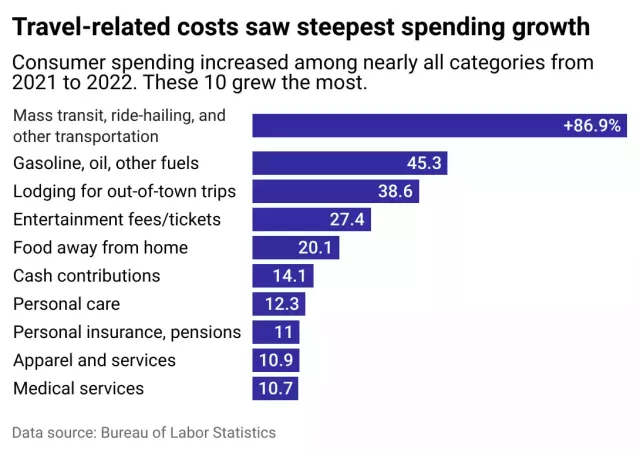
READY TO ELEVATE YOUR SALES GAME?
Everything you need to know to help you create revenue-driven compensation plans.
Spending increased most in these 10 categories in 2022
In the face of rampant inflation, Americans spent about 9% more in 2022 than the previous year. Inflation, which increased 8% over the period, is to blame for much of the spending boost—but not all of it.
American spending habits from before and during the COVID-19 pandemic are converging: People are continuing to spend more on home improvement, even while spending more on travel, entertainment, and renewed work commutes. What's more, while the pull of in-person shopping has returned, most continued to shop online as well.
Many consumers dipped into their savings accumulated during the pandemic with born-again opportunities to spend on travel, concerts, sporting events, maskless window shopping, and routine health and wellness appointments. Indeed, average pretax incomes increased just 7.5% between 2021 and 2022, so the increase in spending wasn't fully supported by added wages. As a result, credit card debt is increasing.
To get a closer look at the areas where Americans increased their spending most from 2021 to 2022, Xactly charted data from the Bureau of Labor Statistics. These spending statistics were released in September 2023 and are the latest available from BLS, as annual data for consumer spending lags by a little under a year. Unsurprisingly, waning fear and restrictions on movements and gatherings have had profound impacts on the areas where people put their dollars.
UNLOCK YOUR FULL REVENUE POTENT[AL
Sales planning, incentive compensation, and forecasting - all in one powerful platform.
Travel-related spending spiked as COVID-era restrictions lifted
After years of being cooped up at home as a result of COVID-era restrictions and precautions, many stir-crazy Americans went out and traveled fervently in 2022. The largest increase was measured in the spending category that includes things like flights, trains, taxis, and ride-hailing services. The most popular destinations included large cities, warmer climates, and regions with newly relaxed travel restrictions. The travel bump also meant Americans spent more on lodging and food outside their primary residences.
Mass transit and gas spending were also influenced heavily by the inflation of fuel prices. Oil and fuel prices were excessively high throughout the year, strained by economic sanctions on Russia following its invasion of Ukraine. At some points throughout 2022, gas prices had doubled from 2021. Regardless of whether Americans traveled more during the year, it inevitably cost them more to get anywhere.
There were also sizable bumps in spending on personal appearance, health, and wellness, another possible side effect of leaving the house and seeing people more frequently. Returning to the office in many cases meant a wardrobe change from the remote work-era sweats and athleisure, and more frequent haircuts and shaves. With a renewed focus on health and wellness, medical services like routine checkups and specialized services were part of another expense category that experienced outsized growth.
As inflation and post-pandemic spending habits normalize, statistics may begin to better reflect how Americans are changing how and where they spend their money.
AI REVENUE SOLUTIONS
Transform your revenue processes with AI Copilot.
Story editing by Ashleigh Graf. Copy editing by Tim Bruns.

